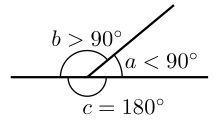Pierre Hérigone
Pierre Hérigone , Latinized Petrus Herigonius, (* around 1580 , † 1643 or 1644 in Paris ) was a French mathematician . It is of Basque origin, as he himself wrote. Little is known about his life, but he mostly lived in Paris.
Occasionally he was identified with the linguist and mathematician Clément Cyriaque de Mangin (1570-1642) or with the printer and mathematician Denis Henrion , which went back to a remark by Claude Hardy . But that is now considered refuted.
life and work
In his Cursus Mathematicus (written in Latin and French), a textbook on elementary mathematics, which appeared in six volumes from 1632 to 1642, Hérigone introduced numerous mathematical notations, for example the expressions for angle, standing vertically, the symbol for smaller (<) and the term Parallelepiped .
It also contained a system named after him of displaying large numbers for the purpose of better memorization, as well as a camera obscura in a cup, with which one could secretly observe others while they were drinking. According to his biographer Per Strømholm (Dictionary of Scientific Biography), the course shows little that is essentially original, but shows his extensive knowledge and understanding of contemporary mathematics. Hardly any of his new notations caught on.
His course is dedicated to François de Bassompierre , who was then imprisoned in the Bastille by Cardinal Richelieu . One explanation could be that the unsold volumes of the first edition were reissued in 1644 as an alleged new edition - by that time Bassompierre was free again and accepted at court with grace.
The first volume deals with geometry (after Euclid , Apollonios von Perge and others), the second arithmetic, calendar calculation and algebra, the third sine, logarithm, interest calculation, applications of mathematics to fortifications and architecture, mechanics, the fourth geography and navigation, the fifth Optics, proportional circles , perspective, theory of the planets according to Ptolemy and Copernicus , sundial and mathematics in music (according to Euclid). A supplementary volume deals with Francois Viète's algebra , cubic equations, planetary theory, applications of the proportional circle, chronology and a directory of mathematical authors.
In his course he is one of the earliest populizers of Francois Viète's algebra . It also shows his efforts, as a forerunner of Leibniz , Giuseppe Peano and others, to develop a universal mathematical language (a topic that was topical in the 17th century for other scientists as well) in which he used logic, Euclid's geometry in symbolic form and other fields who can handle math. In the second volume there are also passages that could have inspired Blaise Pascal for his Pascal's triangle.
With Étienne Pascal and Claude Mydorge and others he was a member of a committee that should judge the longitude determination by moon observation of Jean-Baptiste Morin . The committee judged the method negatively, which led to a longstanding legal battle with Morin. Morin blamed Hérigone in particular for the decision, who also addressed Morin's mistakes in his course and also criticized his work as an astrologer.
He is said to have been one of the best checkers players in Paris.
In 1639 he published a small lexicon of mathematical expressions as a supplement to an annotated Euclid edition (but it essentially corresponds to the French text of the first volume of his course).
The lunar crater Herigonius is named after him.
literature
- Per Strømholm: Pierre Hérigone , Dictionary of Scientific Biography 1972
- María Rosa Massa Esteve: Symbolic language in early modern mathematics: The Algebra of Pierre Hérigone (1580–1643) , Historia Mathematica, Volume 35, 2008, pp. 285–301
- Maria Rosa Massa Esteve: The symbolic treatment of Euclid's elements in Hérigon's Cursus mathematicus , pdf
- B. Boncompagni, in: Bulletino di bibliografia e di storia delle scienze matematiche e fisiche, Volume 2, 1860, pp. 472-476
- Paul Tannery, Mémoires Scientifique, Volume 10, Paris 1930, pp. 287-289
- Florian Cajori: History of Mathematical Notations, Volume 1, Chicago 1928
Web links
- John J. O'Connor, Edmund F. Robertson : Pierre Hérigone. In: MacTutor History of Mathematics archive .
- Cursus, 1st volume at Gallica
Individual evidence
- ↑ In the Dictionary of Scientific Biography only the year of death around 1643 is given, probably in Paris
- ↑ According to Dict. Sci. Biography from 1634
- ^ The first four volumes 1632, the fifth 1637, the last volume 1642
- ^ JC Boulenger, Beaugrand, L. de la Porte
- ↑ Represented in J. Montucla, Histoire des mathématiques, Volume 4, 1802, pp. 543-545
| personal data | |
|---|---|
| SURNAME | Hérigone, Pierre |
| ALTERNATIVE NAMES | Herigonius, Peter |
| BRIEF DESCRIPTION | French mathematician |
| DATE OF BIRTH | 1580 |
| DATE OF DEATH | 1643 |
| Place of death | Paris |

